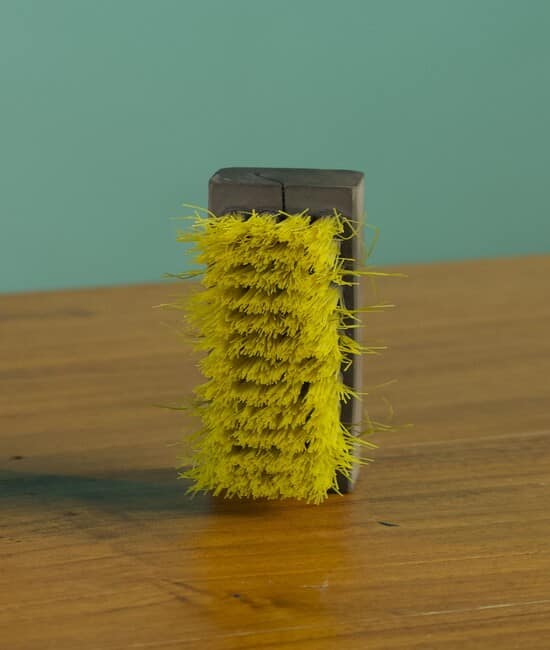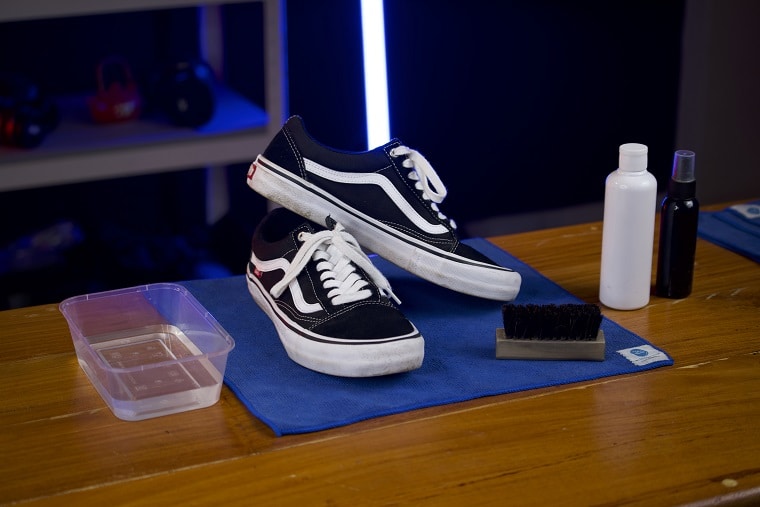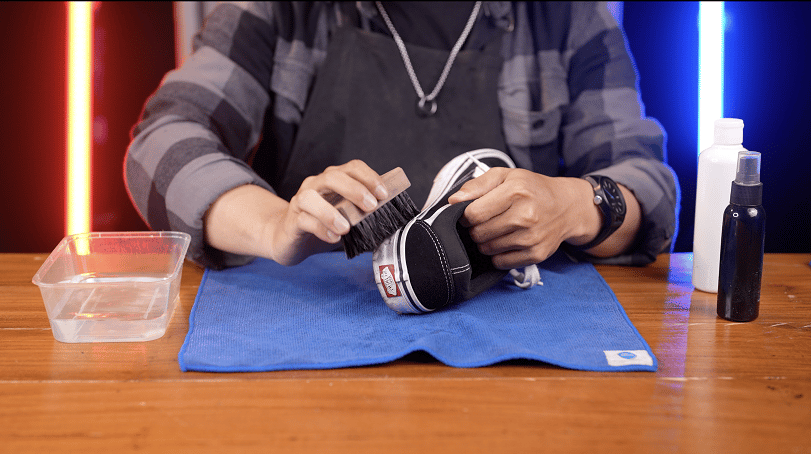
As a professional shoe cleaner, I’ve seen a lot of shoes whose soles are scratched up badly. Most of the time, it’s because the owner doesn’t know the correct procedure to clean them. It is such as shame because once your shoe soles are damaged, then it’s hard to restore them.
In order to avoid such damage from happening, you need to know how to correctly clean your shoe soles. You can do it yourself at home using home cleaning tools, and it’s not that hard to do as well. So, you might want to hear what I have to say about shoe sole cleaning since I will be sharing the details of how to clean white soles with you below.
Contents
- I. Get to Know the Cleaning Kits and Their Functions
- II. Four EASY Ways to Clean White Soles Of Shoes
- III. The Science Behind Cleaning: Why Certain Methods Work?
- IV. Common Mistakes to Avoid When Cleaning White Soles
- V. Do’s and Don’ts
- VI. Caring for your White Soles Post-Cleaning
- VI. Conclusion
- VI. Frequently Asked Questions
I. Get to Know the Cleaning Kits and Their Functions
Before you start the process, it is important to know which tools are ideal for cleaning the midsole. If you do not know which ones to choose, I highly recommend the following kits!
| Cleaning Kit Image | Cleaning Kit Item | Function |
 | Shoe Cleaner | Liquid solution to clean shoes. |
 | Apron | Protect your shirt from dirt. |
 | Medium Brush | Scrub dirt and stains off the shoes. |
 | Microfiber Cloth | Wipe the shoe soles. |
 | Wash Bowl | Medium to mix the shoe cleaner and water. |
 | Shoe Perfume | Give a fragrance and keep the shoes fresh. |
Before we go deeper into the detailed step-by-step on how to clean your white shoe soles, let me help you understand the reason why it is necessary to keep your white shoes soles clean.
II. Four EASY Ways to Clean White Soles Of Shoes
After you understand the necessary kits and their functions, now I shall share my secret cleaning tutorial! My methods are easy to follow and won’t cause a big mess, so you should try it.
a. Steps to Clean Your White Soles Using Shoe Cleaner
Step 1: Prepare the dirty shoes

The first thing to do is get your dirty shoes ready to clean. Take a pair of shoes with dirty midsoles and set them aside. Check thoroughly for scratches before you start scrubbing because you don’t want to worsen the damage.
Step 2: Prepare the cleaning kit

The next step is preparing the cleaning kit. Take shoe cleaner, an apron, a medium brush, microfiber clothes, a basin filled with water, and shoe perfume.
Step 3: Dry-cleaning

Scrub the shoe’s midsole with a medium brush to remove dirt, stain, and dust before cleaning the midsole with water and a shoe cleaner mixture. Scrub thoroughly and repeat the process for the other pair.
I really encourage you to do the dry brushing because it’ll make cleaning much easier. Be gentle when you do this step, especially if your shoe soles use soft rubber. You don’t want to leave ugly scratches, don’t you?
Step 4: Clean the midsole

Dip the medium brush into the water and shoe cleaner mixture, then rub the midsole with the brush to remove dirt and stains.
After the midsole is clean, wipe it off with microfiber clothes. And as I’ve said before, you may use laundry detergents as an alternative if you don’t have a shoe cleaner at home.
Step 5: Detailing

After the midsole is clean, use microfiber clothes to clean and wipe small details of the shoe thoroughly.
Don’t miss any spots or crevices on your shoe. I know that this part is quite tedious, but you have to put some effort into it so you can get rid of the dirt in the tight spots.
Step 6: Drying Process

After the cleaning process is finished, dry your shoes with a fan for about 30 minutes to 1 hour. You don’t have to dry them in the sun since you’re only cleaning the midsole. In fact, I do not recommend putting your shoes under a scorching sun because that can damage the color.
Step 7: Finishing

After the shoes are dry, put them aside, and your shoes are ready to wear. You can also store the shoes in a dry environment. I recommend adding some packs of silica gel to keep them fresh and good.
b. Steps to Clean Your White Soles Using Toothpaste

There are some steps to clean white soles with toothpaste. Being an expert in cleaning, I can tell you that toothpaste is a good agent to clean a lot of items, aside from your teeth of course, which include jewelries and shoes. If you don’t have a shoe cleaner and urgently need to clean your shoes, then I can assure you that toothpaste is a good alternative.
Toothpaste has soft abrasive particles that help remove dirt from numerous dirty surfaces, including shoe soles.
- Prepare the cleaning kits that include a non-gel, preferably whitening toothpaste, an old toothbrush, and a damp towel or cleaning sponge
- Squeeze some toothpaste on the old toothbrush before scrubbing the sole in circular motions.
- Let the paste sit for around 10 to 15 minutes for the best result.
- Use a damp towel or cleaning sponge to wipe off the paste and revel the clean white soles.
c. Steps Clean Your White Soles Using Nail Polish Remover

There are some steps to clean white soles with nail polish remover, also known as acetone. This strong, non-toxic solvent is great for cleaning grease or oily stain from different surfaces.
It’s also excellent for removing scuff marks on your white soles caused by frequent use. But please heed my warning: handle this strong chemical compound with care!
- Prepare some cotton balls, nail polish remover, and the dirty shoes.
- Soak the cotton balls in the nail polis remover liquid
- Rub the soles until they clean and look new.
Nail polish remover is a good alternative to clean your shoes, although this method is useful only for white soles. The reason is the alcohol in nail polish remover might cause discoloring to the canvas or other painted parts of the shoes.
d. Steps to Clean Your White Soles Using Hydrogen Peroxide ad Sun Method

I can tell you that Hydrogen Peroxide is also a good solution to clean your shoes soles. It will brighten your shoe soles and disinfect them from bacteria, fungi and viruses at the same time. You can also mix it with baking soda to make a cleaning paste.
- Mix one part hydrogen peroxide to two parts baking soda, and add water if needed.
- Apply the paste to the upper side as well as the soles of the shoes using a small brush or a toothpaste.
- Place your shoes soles side up in direct sunlight and leave to soak.
- Rinse the paste off your shoes soles and your soles are clean and fresh!
However some stains and dirt can be stubborn, I know. So, if your shoes soles still have some stubborn dirt or yellow marks, you can repeat the above steps.
III. The Science Behind Cleaning: Why Certain Methods Work?
Well, you need to understand the science behind each cleaning method. Below I am going to share several key principles on why certain methods of cleaning work, while others don’t.
A. Chemical Reactions
You need to know that each shoe cleaner works by showing chemical reactions with the substances that need to be removed, such as dirt or stains on your shoes. Different reactions may be caused by different type of cleaners, or also the materials of the shoes.
B. Solubility
Most cleaning solutions, including shoe cleaner products, dissolve in water, making them easy to apply and also remove from the surface of your shoes.
C. Mechanical Action
Cleaning your shoes, especially the soles, requires some mechanical actions that include scrubbing, brushing or wiping, using different cleaning tools. Some of the main shoe cleaning tools include a brush or toothbrush and a cloth.
D. Surfactants
Some shoe cleaner products also have surfactants, which are compounds that make it easier for you to penetrate and lift dirt of stains from the surface of the shoes and soles.
E. Microbiology
Last one, the process of cleaning your shoes also include the process of keeping your shoes off some microorganisms such as bacteria and viruses.
IV. Common Mistakes to Avoid When Cleaning White Soles
Knowing exactly what not to do is as important as knowing what to do. In cleaning your white soles, you need to know exactly what are the common mistakes that you need to avoid when it comes to the process of cleaning your shoes’ white soles.
A. Using the Wrong Cleaning Products
It is necessary for you to know that not all shoes are made of the same materials. Therefore, different shoes require different cleaning products to make sure they are totally clean.
Before you pick a shoe cleaner product, make sure that you read the label and table of ingredients carefully. It will let you know whether it is safe or not to use it to clean your shoes soles. One personal advice, you can test the product on a small area of the soles to make sure it is safe.
B. Using Too Much Water or Detergent
In life sometimes we need to face a condition that makes us realize that ‘less is more’ just like the amount of water or detergent that you need to use to clean your shoes’ soles.
Using too much water or detergent can damage your shoes and the soles, too. So rather than using high-pressure hoses to rinse the dirt or solution after cleaning, you can use a damp cloth instead. Gently wipe away the dirt and use minimal amount of detergent if possible.
C. Ignoring the Shoe Laces
Shoelaces might look as if they are less important than the shoes. But you know what, shoelaces are actually way more important that that. Well, I do admit that it’s easy to over look shoelaces when I am cleaning my shoes, but leaving them dirty can actually make the shoes look scruffy.
So, make sure you take off your shoe laces before cleaning your shoes and the soles, and spare sometime to wash the laces properly and dry them completely under the sun before you put them back in your clean shoes.
D. Not Rinsing Properly After Cleaning
While some people don’t take the last step of cleaning shoes seriously, you need to know that the last steps are actually the most important ones. This applies to the step of rinsing the shoes with water after cleaning.
Rinsing the shoes properly will make sure the dirt, bacteria, detergent are other remaining residues are removed completely from your shoes. So, take sometime to rinse your shoes after cleaning, no need to rush! Then, allow them to dry completely before wearing or storing them back inside the box.
E. Not Following Up with Protection or Perfume
When you are done with rinsing, do convince yourself not to skip this very last step. After your shoes are clean and completely dry, spare some time to protect them with a shoe protection spray or cream.
Nope, it’s not only to add some fragrance to your shoes, but it will also make sure your shoes are always looking their best. Moreover, protection and fragrance will also prevent dirt and from sticking, too.
V. Do’s and Don’ts
It seems like you have understood step by step how to clean the white midsole of your shoes. Now, it’s time for some tips on what to do and not to do while cleaning the midsole.
Do’s
- Clean the shoes thoroughly, so you don’t miss any dirt or stain on the shoe midsole.
- Scrub the midsole just enough to brush off hard-to-remove dirt and stains.
- Clean your shoes regularly to remove the dirt easily and avoid dirt accumulation.
- Immediately clean your shoes if they become dirty and stained.
Don’ts
- Don’t use a rough and hard-bristles brush to clean the midsole because it might scratch and damage the midsole.
- Don’t use dampened tissue towel to clean the midsole.
- Don’t use a non-shoe cleaner solution to remove the dirt and stain from the shoe midsole because the product might cause damage. Homemade ones are okay if you know the best composition, though!
- Don’t scrub the midsole too hard to avoid scratches and damage.
VI. Caring for your White Soles Post-Cleaning
There are several important things to do in order to make sure your white soles stay clean after cleaning.
| Caring Steps | Functions |
| Don’t store your shoes in a humid environment | A humid environment is an ideal place for fungus and bacteria to grow, causing your shoe to smell nasty and moldy. |
| Don’t store wet shoes inside the shoe box | Keeping your wet shoes directly inside the box will make them get moldy and they make bacteria grow rapidly. |
| Always use silica gel packs while storing shoes | Adding some pockets of silica gel can help to maintain the shoes’ condition and extend their lifetime. |
| Air dry shoes after wearing them | It’s best to air dry your shoes after wearing them, especially after heavy physical activity, before you put them back in the box. |
| Clean the shoes immediately if the midsole is dirty | The longer you let the dirt and stains stick, the harder they become. |
VI. Conclusion
I know that cleaning white rubber soles on your shoes can be super tricky! This part of the shoes gets exposed to dirt and mud daily, so it gets dirty in no time. You might also accidentally scratch the soles because you stumble around on a gravel road. While the white soles on the shoes look cool, they are hard to maintain!
Fortunately, there are various methods to make the white soles sparkling again! Use specialized acrylic-based shoe paint to obscure the scratches, and use alternative soles cleaners like baking soda, vinegar, toothpaste, or even acetone. Either way, follow my methods so that you can clean the white soles on our shoes without scratching them!
Latest post:
- Where Are Vans Made? (Ultimate Guide Revealed)
- How Much Do Shoes Weigh?
- Lights On, Troubles Gone: How to Fix LED Shoes Like A Pro
- Do Vans Run Big or Small? (All You Need To Know)
- Do Adidas Run Big, Small or True to Size?
VI. Frequently Asked Questions
1. How do I clean white rubber shoes that turned yellow?

You can repaint the yellowish part and make them look brand new with special midsole markers. Applying a layer of midsole markers with an acrylic base is the perfect choice to make your shoe soles white again.
Besides repainting, I also recommend a special shoe cleaner to remove the yellow stain. Shoe cleaner, similar to detergent, has small molecules that can bind dirt and grease from the sole, making it clean and look brand new.
2. How to remove scuff marks from white rubber soles?

Remove scuff marks from a white rubber sole by using wet microfiber clothes and shoe cleaner, then scrub gently to remove them. My preferred alternative to removing scuff marks is toothpaste! Scrub the toothpaste on the scuffed sole and see the difference!
Scrubbing the scuffed part with either shoe cleaner or toothpaste slowly sands off the imperfect surface and makes them polished as new.
Note that some scuff marks still remain and are hard to remove even after several cleaning processes, especially when the scratches are deep enough and caused by frequent use. I think a pair of worn-out shoes have a certain unique charm on their own, though!
3. How do you clean white soles from yellowing?

There are several ways for you to clean white soles from yellowing. One of them is scrubbing the yellowing soles with water and shoe cleaner or detergent mixture. You may use a medium brush to help the cleaning process.
Shoe cleaner and detergents pull all dirt, stain, and grease from the shoes. As you rinse the shoes, the dirt and detergent residues are washed away and making your shoes clean.
Another easy way to make the sole white again is by repainting it. Numerous midsole markers are available for you to paint the yellowing sole and make them white as new. The acrylic-based markers are water resistant and won’t leave a mess behind after being applied, making them ideal for covering up the yellowing white soles.
Other shoe-cleaning experts recommend that you use hydrogen peroxide to whiten your shoe soles. Though, this ingredient can be dangerous if you do not handle it properly. Use it with caution.
